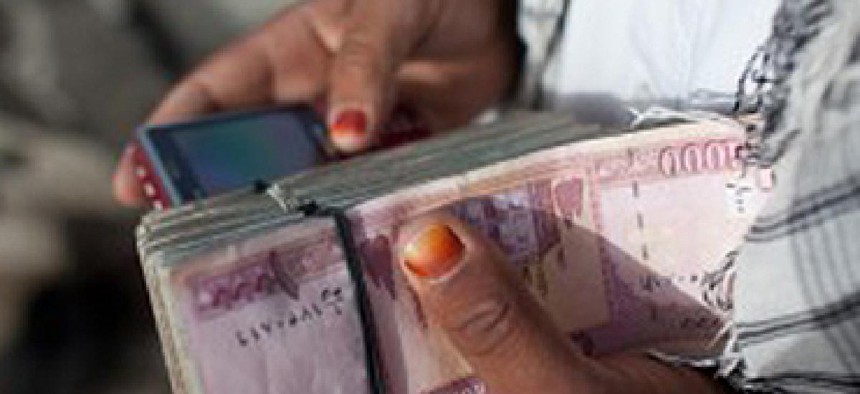USAID tackles mobility in the developing world

USAID's mission demands a very different approach to mobile projects than other agencies take.

Mobile money is a key mobility initiative for USAID, intended to sidestep government graft and streamline the paying of government employee salaries. (USAID photo)
Can international development go mobile? That's the question being asked inside the mobility office of the United States Agency for International Development.
Across the field of international development, mobile tools are being used to create collaborative crisis maps of areas stricken by natural disaster, disseminate health information, facilitate election monitoring, and help people without access to traditional financial services bank their money and conduct transactions.
As director of USAID's mobility office, Priya Jaisinghani works on developing policy to guide investment in mobile and technology, advising other parts of the large USAID organization on mobile solutions, and using their own central budget to start new initiatives. Just a year-and-a-half old, the mobility effort is getting its own line for the first time in President Obama's recent budget request.
A mobile money initiative is the flagship project of USAID's mobility team. The agency works with governments in Afghanistan, Colombia, Haiti, Peru, and the Philippines to identify avenues of mobile payment, which can work as an anti-corruption measure in countries where public sector salaries are subject to systematized graft. For example, police officers in Wardak province in Afghanistan saw their take-home pay go up 30 percent when their salaries shifted from cash to mobile money. The agency is putting tens of millions of dollars into programs to support country-level mobile money initiatives, said Jaisinghani.
USAID also encourages countries to develop bank and technology regulations that support the safe, reliable transmission of money across mobile platforms. Last year, the agency helped launched the Better than Cash alliance, with partners like the United Nations, the Bill and Melinda Gates Foundation, and Visa, to try to accelerate the adoption of mobile money worldwide. The agency also sees mobile money as a way to drive financial access for women in parts of the developing world where purse strings are traditionally controlled by men.
As a part of the development community, USAID often has been ahead of other agencies when it comes to digital mobility. This is in large part because mobile devices are ubiquitous in the developing world, even where other kinds of infrastructure are absent. According to the International Telecommunications Union of the United Nations, mobile penetration is 89 percent in the developing world, and globally there are an estimated 6.8 billion cellular subscriptions for world population of just over seven billion. USAID's chief innovation officer Dr. Maura O'Neill recently said, "We are very careful within the development community to not talk about silver bullets for meeting our development objectives. But the mobile phone is pretty darn close. It is the game changer in development."
Mobile is also playing a part in education efforts in developing countries. Historically, USAID has been forward-looking in investing in new education platforms, said Anthony Bloome, an education technology specialist at USAID. They've backed children's television, interactive radio instruction, and they're looking at mobile phones as a way to do educational assessments and to promote literacy. "We're optimistic about technology adding value," Bloome said. "The main test when it comes to technology in the classroom is can you connect it to increasing learning outcomes."
Metrics are the key when evaluating whether to invest in a mobility project, Jaisinghani says. While mobile money services are typically secure and accessible via the most basic devices. She says she's skeptical about the efficacy of applications that use the phone as a "two-way information platform," as is the case with projects like crisis mapping, election monitoring, and health data collection. "While I'm enthusiastic, my role in this large organization is to help drive a policy of driving investment to platforms that can really reach scale. Not lots of homegrown solutions that don't connect to each other."
The mobile development space suffers from what Jaisinghani describes as "pilot-itis," – lots of donor funded pilot projects that serve small groups or communities, rather than scaled information platforms.
"Let's build upon platforms that can simultaneously get health, agriculture, and election information – there's no reason these need to be one-off bespoke solutions," she said. "If we're going to invest taxpayer dollars, we should be doing that with an eye toward platforms that can develop information services that we know are critical to low-income families around the world."



